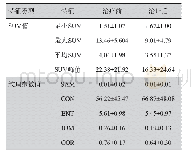《Table 1 Parameters of the microstructure and texture of the Cu-44%Ni alloy determined using the EBS
 提示:宽带有限、当前游客访问压缩模式
提示:宽带有限、当前游客访问压缩模式
本系列图表出处文件名:随高清版一同展现
《冷轧形变量和退火温度对Cu-44%Ni合金的微观组织及织构演变的影响(英文)》
In order to understand the effect of rolling reduction on the formation of the texture and microstructures on a local scale,the annealed Cu-Ni alloys were also analyzed by EBSD.Fig.4 presents the EBSD maps of Cu-44%Ni alloys annealed at 900°C for 1 h.Fig.5 shows the fractions of the main texture components which are measured by means of EBSD.From Fig.4 and Fig.5,it is clearly seen that the rolling reduction exerts a great influence on achieving a strong cube texture.After annealing at 900°C,the 70%cold-rolled Cu-44%Ni shows the presence of only a few recrystallized cube grains with the majority of non-cube grains.With the rolling reduction up to 80%,the fraction of cube component in the annealed specimen increases slightly,but still has many non-cube grains.However,as rolling reduction increases from 80%to 90%,the recrystallization microstructure is dominated by the cube grains.When the rolling reduction reaches to 99%,the cube component is further strengthened after annealing at 900°C resulting in93.9%.Furthermore,the average recrystallized grain size decreases from 28.3μm to 18.4μm with increasing rolling reduction.And the sharpening of cube texture is also accompanied by the reduction of HAGBs andΣ3boundaries.The results mentioned above are displayed in Table 1.
| 图表编号 | XD0011249300 严禁用于非法目的 |
|---|---|
| 绘制时间 | 2018.07.01 |
| 作者 | 陈兴品、陈丹、孙洪福、王丽霞 |
| 绘制单位 | 重庆大学、重庆大学、重庆大学、重庆大学 |
| 更多格式 | 高清、无水印(增值服务) |
查看“Table 1 Parameters of the microstructure and texture of the Cu-44%Ni alloy determined using the EBSD technique”的人还看了
-

- 表1 治疗前后肿瘤的SUV值和纹理参数值Tab.1 SUV and texture parameters of the tumor before and after treatment (Mean±SD)





